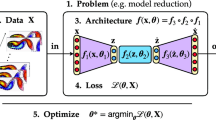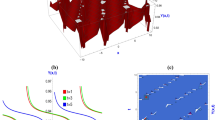Abstract
The complexity and size of state-of-the-art cell models have significantly increased in part due to the requirement that these models possess complex cellular functions which are thought—but not necessarily proven—to be important. Modern cell models often involve hundreds of parameters; the values of these parameters come, more often than not, from animal experiments whose relationship to the human physiology is weak with very little information on the errors in these measurements. The concomitant uncertainties in parameter values result in uncertainties in the model outputs or quantities of interest (QoIs). Global sensitivity analysis (GSA) aims at apportioning to individual parameters (or sets of parameters) their relative contribution to output uncertainty thereby introducing a measure of influence or importance of said parameters. New GSA approaches are required to deal with increased model size and complexity; a three-stage methodology consisting of screening (dimension reduction), surrogate modeling, and computing Sobol’ indices, is presented. The methodology is used to analyze a physiologically validated numerical model of neurovascular coupling which possess 160 uncertain parameters. The sensitivity analysis investigates three quantities of interest, the average value of \(\hbox {K}^{+}\) in the extracellular space, the average volumetric flow rate through the perfusing vessel, and the minimum value of the actin/myosin complex in the smooth muscle cell. GSA provides a measure of the influence of each parameter, for each of the three QoIs, giving insight into areas of possible physiological dysfunction and areas of further investigation.









Similar content being viewed by others
References
Alexanderian A, Gremaud P, Smith R (2018) Variance-based sensitivity analysis for time-dependent processes, under revision, arXiv:1711.08030
Attwell D, Buchan AM, Charpak S, Lauritzen M, Ba MacVicar, Ea Newman (2010) Glial and neuronal control of brain blood flow. Nature 468(7321):232–243
Bellot-Saez A, Kékesi O, Morley JW, Buskila Y (2017) Astrocytic modulation of neuronal excitability through \(\text{ K }^{+}\) spatial buffering. Neurosci Biobehav Rev 77:87–97
Chang JC, Brennan KC, He D, Huang H, Miura RM, Wilson PL, Wylie JJ (2013) A mathematical model of the metabolic and perfusion effects on cortical spreading depression. PLoS ONE 8(8):e70,469
Dormanns K, Brown RG, David T (2015a) Neurovascular coupling: a parallel implementation. Front Comput Neurosci 9(September):1–17
Dormanns K, van Disseldorp EMJ, Brown RG, David T (2015b) Neurovascular coupling and the influence of luminal agonists via the endothelium. J Theor Biol 364:49–70
Dormanns K, Brown R, David T (2016) The role of nitric oxide in neurovascular coupling. J Theor Biol 394:1–17
Efron B, Hastie T, Johnstone I, Tibshirani R (2004) Least angle regression. Ann Stat 32(11):407–499
Farr H, David T (2011) Models of neurovascular coupling via potassium and EET signalling. J Theor Biol 286(1):13–23
Filosa JA, Bonev AD, Straub SV, Meredith AL, Wilkerson MK, Aldrich RW, Nelson MT (2006) Local potassium signaling couples neuronal activity to vasodilation in the brain. Nat Neurosci 9(11):1397–1403
Filosa JA, Blanco VM (2007) Neurovascular coupling in the mammalian brain. Exp Physiol 92(4):641–646
Hai CM, Murphy RA (1988) Cross-bridge phosphorylation and regulation of latch state in smooth muscle. Am J Physiol Cell Physiol 254(1):C99–C106
Hart J, Gremaud P (2018) An approximation theoretic perspective of Sobol’ indices with dependent variables. Int J for Uncertain Quant
Hart J, Alexandrian A, Gremaud P (2017) Efficient computation of Sobol’ indices for stochastic models. SIAM J Sci Comput 39:A1514–A1530
Hsieh NH, Reisfeld B, Bois FY, Chiu WA (2018) Applying a global sensitivity analysis workflow to improve the computational efficiencies in physiologically-based pharmacokinetic modeling. Front Pharmacol 9:588
Iooss B, Saltelli A (2017) Introduction: sensitivity analysis. In: Ghanem R, Higdon D, Owhadi H (eds) Handbook of uncertainty quantification. Springer, Berlin, pp 1103–1122
Kager H, Wadman WJ, Somjen GG (2000) Simulated seizures and spreading depression in a neuron model incorporating interstitial space and ion concentrations. J Neurophysiol 84(1):495–512
Kenny A, Plank MJ, David T (2017a) The role of astrocytic calcium and \(\text{ TRPV }_4\) channels in neurovascular coupling. J Comput Neurosci. https://doi.org/10.1007/s10827-017-0671-7
Kenny A, Plank MJ, David T (2017b) The role of astrocytic calcium and \(\text{ TRPV }_4\) channels in neurovascular coupling. J Comput Neurosci 41(1):97–114 in press
Kenny A, Plank M, David T (2018) Macro scale modelling of cortical spreading depression and the role of astrocytic gap junctions. J Theor Biol 458:78–91
Leithner C, Royl G, Offenhauser N, Füchtemeier M, Kohl-Bareis M, Villringer A, Dirnagl U, Lindauer U (2010) Pharmacological uncoupling of activation induced increases in CBF and \(\text{ CMRO }_2\). J Cereb Blood Flow Metab: Off J Int Soc Cereb Blood Flow Metab 30(2):311–322
Lindauer U, Leithner C, Kaasch H, Rohrer B, Foddis M, Füchtemeier M, Offenhauser N, Steinbrink J, Royl G, Kohl-Bareis M, Dirnagl U (2010) Neurovascular coupling in rat brain operates independent of hemoglobin deoxygenation. J Cereb Blood Flow Metab 30(4):757–768
Longden TA, Hill-Eubanks DC, Nelson MT (2015) Ion channel networks in the control of cerebral blood flow. J Cereb Blood Flow Metab 36:492–512
Makani S, Chesler M (2010) Rapid rise of extracellular pH evoked by neural activity is generated by the plasma membrane calcium ATPase. J Neurophysiol 103(2):667–676
Marelli S, Sudret B (2014) UQLab: a framework for uncertainty quantification in Matlab. In: 2nd International conference on vulnerability, risk analysis and management
Marin JM, Pudlo P, Robert CP, Ryder RJ (2012) Approximate Bayesian computational methods. Stat Comput 22(6):1167–1180
Mathias EJ, Plank MJ, David T (2017a) A model of neurovascular coupling and the BOLD response: PART I. Comput Methods Biomech Biomed Eng 20(5):508–518
Mathias EJ, Plank MJ, David T (2017b) A model of neurovascular coupling and the BOLD response: PART II. Comput Methods Biomech Biomed Eng 20(5):519–529
Mathias EJ, Kenny A, Plank MJ, David T (2018) NeuroImage Integrated models of neurovascular coupling and BOLD signals: responses for varying neural activations. NeuroImage 174(February):69–86
Mintun MA, Lundstrom BN, Snyder AZ, Vlassenko AG, Shulman GL, Raichle ME (2001) Blood flow and oxygen delivery to human brain during functional activity: theoretical modeling and experimental data. Proc Natl Acad Sci USA 98(12):6859–6864
Owen A (2014) Sobol’ indices and Shapley values. SIAM/ASA J Uncertain Quant 2:245–251
Powers WJ, Hirsch IB, Cryer PE (1996) Effect of stepped hypoglycemia on regional cerebral blood flow response to physiological brain activation. Am J Physiol 270(2 Pt 2):H554–9
Roy CSCS, Sherrington CSS (1890) On the regulation of the blood-supply of the brain. J Physiol 11(1–2):85
Saltelli A, Ratto M, Andres T, Campolongo F, Cariboni J, Gatelli D, Saisana M, Tarantola S (2008) Global sensitivity analysis: the primer. Wiley, Hoboken
Saltelli A, Annoni P, Azzini I, Campolongo F, Ratto M, Tarantola S (2010) Variance based sensitivity analysis of model output. Design and estimator for the total sensitivity index. Comput Phys Commun 181:259–270
Sobie EA (2009) Parameter sensitivity analysis in electrophysiological models using multivariable regression. Biophys J 96:1264–1274
Tennøe S, Halnes G, Einevoll GT (2018) Uncertainpy: a python toolbox for uncertainty quantification and sensitivity analysis in computational neuroscience. https://doi.org/10.1101/274779
Witthoft A, Filosa JA, Karniadakis GE (2013) Potassium buffering in the neurovascular unit: models and sensitivity analysis. Biophys J 105(9):2046–2054
Zheng Y, Pan Y, Harris S, Billings S, Coca D, Berwick J, Jones M, Kennerley A, Johnston D, Martin C, Devonshire IM, Mayhew J (2010) A dynamic model of neurovascular coupling: implications for blood vessel dilation and constriction. NeuroImage 52(3):1135–1147
Author information
Authors and Affiliations
Corresponding author
Additional information
Publisher's Note
Springer Nature remains neutral with regard to jurisdictional claims in published maps and institutional affiliations.
J. L. Hart was supported in part by the National Science Foundation (NSF) award NSF DMS-1522765.
P. A. Gremaud was supported in part by National Science Foundation (NSF) awards NSF DMS-1522765 and DMS-1745654.
Electronic supplementary material
Below is the link to the electronic supplementary material.
Appendix
Appendix
Determining the coefficients \(c_{\varvec{\alpha }}\) in the Polynomial Chaos surrogate (8) is challenging. Ideally, one would solve the least-squares problem
to determine the coefficients. This approach is not currently feasible for the problems considered in this article. If there are, for instance, 18 input variables (\(\theta _{j_i}\)’s), then a 3rd-degree polynomial has 1330 unknown coefficients and a 4th-degree polynomial has 7315 unknown coefficients. With less than 1000 sample points, as in our case, (18) will admit infinitely many solutions which interpolate the data but will yield poor approximations of the QoI. Rather, we seek an approximate solution of (18) for which most of the coefficients are exactly 0. This may be achieved by introducing a penalty term and solving
instead of (18). Adding the sum of absolute values of the coefficients encourages a sparse solution, i.e., one with many 0 coefficients. However, it comes at the cost of making the objective function non-differentiable and hence (19) requires a more sophisticated optimization approach in comparison with (18). A plurality of well-documented methods exist for solving (19). In this article, we use Least Angle Regression (LAR) (Efron et al. 2004) with its implementation in Marelli and Sudret (2014), and a maximum polynomial degree of 5.
Because the basis function of the Polynomial Chaos surrogate is orthogonal with respect to the PDF \(p_{\hat{\varvec{\theta }}}\), the variance and conditional expectation in (11) may be computed analytically as a function of the coefficients. Hence, the total Sobol’ indices of the Polynomial Chaos surrogate are given in closed form as a function of the coefficients.
Rights and permissions
About this article
Cite this article
Hart, J.L., Gremaud, P.A. & David, T. Global Sensitivity Analysis of High-Dimensional Neuroscience Models: An Example of Neurovascular Coupling. Bull Math Biol 81, 1805–1828 (2019). https://doi.org/10.1007/s11538-019-00578-0
Received:
Accepted:
Published:
Issue Date:
DOI: https://doi.org/10.1007/s11538-019-00578-0




